I can’t believe that we have lived in Arizona for 16 years and have never heard of Salome Jug! This hike is the perfect combination of intense beauty and high adventure. It is hands-down our favorite hike that we’ve ever done in Arizona!
However, this hike is not for everyone and can prove to be dangerous if you are not prepared and don’t know what to expect.
When I was researching Salome Jug, there was limited information about this hike. There is so much that we learned that I feel is important to pass along to help better educate visitors.
My hope is not only to inspire others to get out and explore, but also to inform visitors so that they can explore responsibly and safely.
I am sharing our experience, but you are hiking at your own risk so I would recommend doing other research as well before attempting this hike.
*Disclaimer: This post contains affiliate links. If you make a purchase or book a reservation through the provided link then we will receive a small commission at no extra cost to you. We really appreciate your support!
What you should know before hiking Salome Jug
Table of Contents
- The Jug Trail information
- How to get to Salome Jug
- Hiking the Salome Jug Trail
- Hiking through Salome Creek slot canyon
- Making the jump at Salome Jug
- The last leg of the Salome Jug trail
- When is the best time to hike Salome Jug?
- What to pack when hiking Salome Jug
The Jug Trail information
- Distance: 5.6 miles roundtrip
- Rated: Difficult
- Time: 5-6 hours
- Notes: Not recommended for kids under 12 years old. Must be a strong swimmer. Do not attempt if you are afraid of heights. Always check the weather and do not attempt to enter the canyon if there is rain in the forecast. Canyoneering equipment is recommended. This hike can only be done during the spring runoff, typically in April and May.
How to get to Salome Jug
Salome Jug is located northwest of Roosevelt Lake in the Salome Wilderness Area. The best way to reach the trail is via Hwy 87 (N Beeline Hwy) towards Payson. It took us about 2 hours 15 minutes from Gilbert.
From HWY 87, you’ll exit right onto HWY 188 before reaching Payson. You’ll pass by the small community of Punkin Center, then after about 5 miles, you’ll take a left onto Bar X Rd.
This dirt road will continue for 0.4 miles until you come to a river crossing. A high-clearance vehicle is highly recommended to cross the river. We did not need to engage our 4WD, but it would be helpful to have just in case.
Do not attempt to cross the river after a storm when it is too high or running too fast.
After one mile the road is paved again. You’ll be on Bar X Rd for 3.6 miles until you reach a fork in the road. Take the left fork onto FR 60. You’ll continue along this dirt road for about 8 miles.
You’ll have to take it pretty slow but the views of the saguaro cactus framing Roosevelt Lake are spectacular.
If you put “Jug Trail Salome Wilderness” into your maps, it will take you directly to the trailhead, but hopefully this gives you an idea of what to expect on the drive there.
When you arrive, there is a small parking lot at the trailhead but parking is available along the road if it is filled up.
There are no restrooms on-site. There are also no garbage cans so be sure to pack out everything that you pack in and keep our lands beautiful.
Also note that a limit of 15 people in a group is enforced year-round, according to the Tonto National Forest website.
Hiking the Salome Jug Trail
The beginning of the trail is easy to find. It is an old jeep trail that follows gradually down to the canyon.
The trail traverses through open desert terrain dotted with blooming saguaro cactus. The trail down is easy with only a gradual descent, but there is no shade.
Bring plenty of water and apply sunscreen (this is my favorite sunscreen for your face!) if you’re visiting on a hot day.
Also, in the spring when everything is in bloom, you’ll find swarms of flying bugs so bug spray would be helpful.
Keep your eye out for Diamondbacks and Arizona Black Rattlesnakes that call this desert home.
After about 2 miles you’ll come to this large rock topped with a rock cairn. The trail forks here, if you go to the right you will come to the canyon’s exit, so go to the LEFT to reach the entrance.
The trail will continue for about .3 miles. You’ll know you’re going the right way when you come to this makeshift gate.
The fence is used to keep grazing cattle in, so you’ll need to open and close the gate as you pass through.
You’ll soon begin to catch a glimpse of the beautiful canyon.
The trail will veer to the right where you’ll need to scramble down some rocks to reach the water and the beginning of the slot canyon hike.
It’s not totally obvious where to make your way down, so just look for the best route to reach the river.
Hiking through Salome Creek slot canyon
We were told that the water is freezing cold, but we visited during the afternoon in the middle of May when it was 97 degrees outside and the water felt perfect!
The beginning of the canyon consists of a series of small pools. It was so relaxing to sit and cool off in this desert oasis.
Many people opt to come and just swim and play in these pools or the shallow pool at the end of the canyon.
That is a great option for those with younger kids or those who are not confident about hiking through the canyon.
If you are looking for a great waterfall hike with kids, I would also recommend Fossil Creek Falls.
Continue down the river and you’ll come to the first water slide where the fun really begins!
There will be four waterslides that you’ll come across on the hike and plenty of places to stop and play.
The third one has a mellow slide to the right and a more adventurous slide on the left.
The fourth slide was our favorite. It was pretty steep, but all the slides are smooth and don’t hurt to go down.
This canyon truly is remarkable. You’ll slide down natural water slides, dive into deep pools of crystal clear water, and float through narrow snaking ravines.
As you make your way deeper into the canyon, you’ll notice the sheer cliffs getting taller and the slot canyon becoming more narrow.
The canyon is one mile long, but plan to spend a few hours just playing along the way. It was better than any water park we had ever been to!
For the most part, this portion of the canyon is not too difficult.
Of course, the conditions can vary depending on the amount of water in the canyon and the speed of the flow.
The water is generally clean and clear during the spring run off. The water becomes more stagnant later in the season or if it was a particularly dry winter.
As with all river hikes, it can be easy to lose your footing so a hiking pole would be helpful.
There are also a few areas where you will be maneuvering over slippery rocks as the water is flowing over them. Be sure to wear water shoes with good traction and proceed slowly and cautiously.
Making the jump at Salome Jug
As fun as the canyon is, this last jump, known as the “heart of the jug”, is what earns it the difficult rating.
This is also the reason that this hike is not for everyone, particularly young kids and those afraid of heights.
We brought our (almost) 12-year-old, but he is a strong swimmer and loves to cliff jump at the lake so we knew he could handle it.
We didn’t bring our 9-year-old and I’m so glad that we didn’t! I would recommend this hike for 12 years and older, but even then it still depends on their skill and personality.
As you get towards the end of the canyon, you will see a rope attached to the side of the rock. This leads to a ledge overlooking a small waterfall and a deep pool of water.
You’ll need to grasp the rope and carefully make your way out to the end. The rock is very slippery when wet, so use extreme caution.
Once you get to the end, there is not really a good ledge to stand on. The rock slopes downward and inward and is quite slippery.
It is hard to get your footing, but try your best to stand and jump or at least crouch on your feet. I made the mistake of just scooting off the edge and ended up landing on my side and it didn’t feel too good!
Everyone else jumped from their feet and were just fine as they entered the water feet first.
When researching the hike, some sites said this was a 25-foot jump, others said it was 50 feet.
It does vary depending on the water level, but when we visited in May we estimated it to be about 30-35 feet.
It definitely looks higher from the top than when you’re at the bottom!
If you are experienced at rappelling and have the equipment, it is recommended that you rappel down this last ledge. Some will even argue that this hike is considered technical canyoneering.
If you visit in the summer months when the water level is too low, then rappelling is mandatory.
However, if you visit in the spring when the canyon is filled with snow runoff then the water is deep enough to safely make the jump.
This is the only way out of the canyon. Due to the waterfalls and slides along the way, it is impossible to make your way back up through the canyon.
If you plan to do this hike, just know that you will be required to make this jump at the end.
It is a lot of fun, especially if you like an adrenaline rush, but it can also be quite dangerous.
There have been one too many injuries and canyon rescues over the years, so please practice extreme caution and do not attempt if you have any reservations.
If you are nervous or have any hesitations, I would highly recommend booking a guided tour with experienced guides that have the proper equipment and knowledge.
Just be sure to specify that you want the Salome Jug Tour as they offer other canyoneering tours (which I’m sure are equally great!).
The last leg of the Salome Jug trail
Once you take the big leap, you’ll want to catch your breath before the last leg of your adventure.
There are several deep pools that you’ll need to swim through to make it out of the canyon. This part was more challenging than I had anticipated.
At this point, we were all pretty exhausted and the water is colder due to the deep shade of the canyon, so it takes your breath away.
Swimming with shoes, clothes, and a backpack on also makes it more difficult.
I ended up flipping onto my back and using my Camelbak as a flotation device and just back stroked my way out.
Not everyone struggled with this part, but I am just sharing my experience so that you can be prepared.
You’ll soon see the sun filtering through the imposing cliffs and sparkling off the shallow water as you make your way out of the canyon.
We were so happy when we finally made it to this point!
The shallow pool is the perfect spot to rest and give each other props for finishing such an epic adventure!
You’ll see a sign on the right marking the exit trail. Follow the trail up, then after about .3 miles, it will connect back onto the same trail that you came down.
We had two different people tell us that we were going the wrong way as we were heading down the trail and they were heading up.
It may seem confusing, but don’t worry it is the same trail. The trail back up is about 2.3 miles, with a gradual ascent.
When is the best time to hike Salome Jug?
The best time to hike Salome Jug is in the springtime when the canyon is fed with the spring runoff.
There is some water in the canyon year-round, but the water is frigid in the winter, and in the summer and fall the level is too low to safely make the jump at the end.
The water also becomes stagnant in the summer with a thin layer of algae on top.
If there has not been spring runoff then the water level can still be low even in the spring.
The water level is higher during monsoon season, but never attempt to enter the canyon during monsoon season. Flash floods are common and can occur even if the storm is miles away.
April and May are the best months to visit, It is usually possible to visit in March as well, but just know that it will be cold!
Some years it is possible in early June, it all depends on how much runoff there is from the mountains. You will need to do a little research to determine if it is safe.
Your experience can also vary depending on what time of day you visit. Most people try to get there early to beat the crowds. The problem with this is that everyone shows up early.
We arrived at the trailhead at 12:30 pm on a Saturday and the road was lined with cars.
However, as we were heading down everyone was heading out. We talked to a few hikers that said they had to wait for over an hour at the last jump because there were so many people all bottlenecked at that point.
There were several groups rappelling and several people having panic attacks and not wanting to jump. They also said that the water was freezing cold in the morning.
Our experience was completely different. We got down to the water around 1:15, it was the perfect temperature, and we pretty much had the whole canyon to ourselves.
Just keep in mind that if you do go in the afternoon, you want to be sure to get out before the sun starts setting.
We exited the canyon around 5:30 and it was starting to get cold even though the sun was still out.
If you are able to go on a weekday I’m sure it would be less crowded as well.
*Related post: To discover more Arizona hidden gems, be sure to visit our guide 7 Underrated Spots in Arizona and 4 Day Arizona Hidden Gem RV Road Trip!
What to pack when hiking Salome Jug
- A dry backpack is necessary on this hike since it will often be submerged in water. Be sure to keep your keys in a secure pocket of the backpack, you do not want to lose them in the water and be stranded!
- Hiking poles would be helpful to keep your footing in the river.
- It is important to have lightweight water shoes with good traction. My daughter hiked in Tevas and they also worked great.
- Do not bring any electronic equipment that can’t get wet. If you want to document your adventure, we have the GoPro Hero 9 and love the video quality. I also brought my iPhone 11 because I love the photo quality. It worked fine on this hike because it is waterproof, however, it did take a few hours for it to dry out enough to charge and for the speakers to dry out.
- I love hiking with a Camelbak or hydration backpack, especially on this hike. You will want to stay hydrated without having a backpack weighed down with water bottles.
- If you are concerned about swimming in the deeper water, bring a lightweight life jacket that isn’t too cumbersome to hike in.
- If you are coming early in the spring or early in the morning, you may want to consider wearing a wet or drysuit.
- Apply sunscreen and bug spray at your car before starting the trail.
- Be sure to pack plenty of food and snacks to leave in the car, there are no restaurants or stores nearby.
- Wear lightweight clothes that are easy to swim in. For girls, I would recommend wearing shorts or leggings over your swimsuit. The rocks are smooth for the most part but can be a little rough if you are sliding down in just a swimsuit.
- If you are experienced at canyoneering, be sure to bring the proper equipment for rappelling.
We went home completely exhausted and were sore the next day, but it was so worth it! Salome Jug really is such an incredible place to explore, just be safe!
Pin it for later:

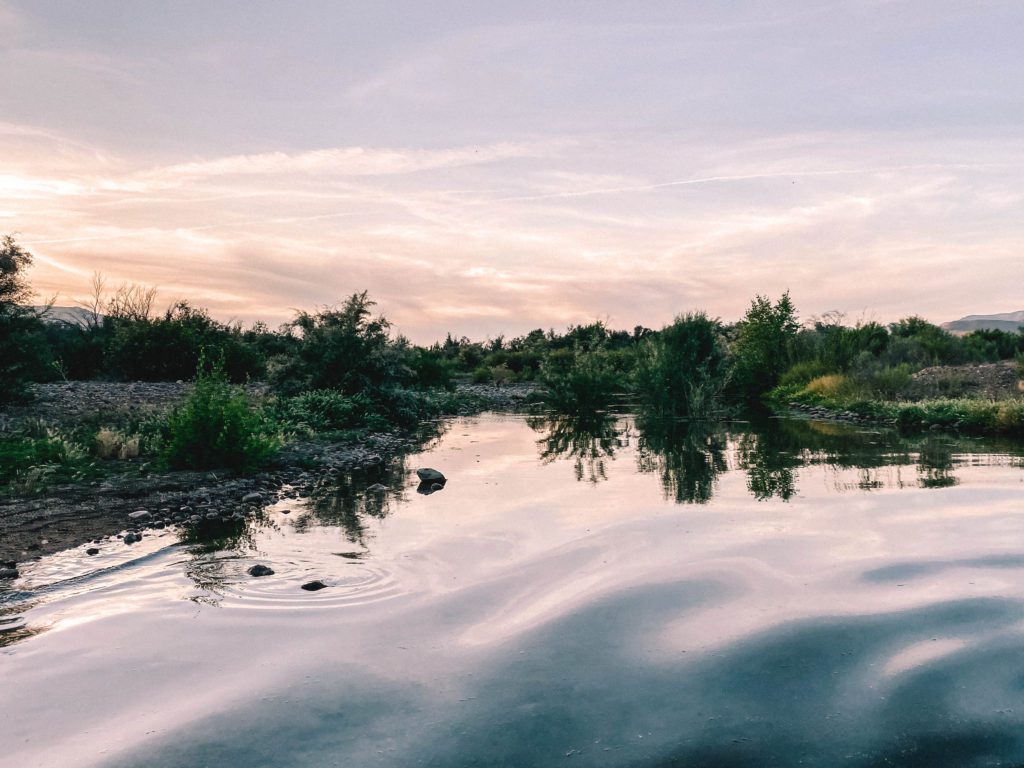
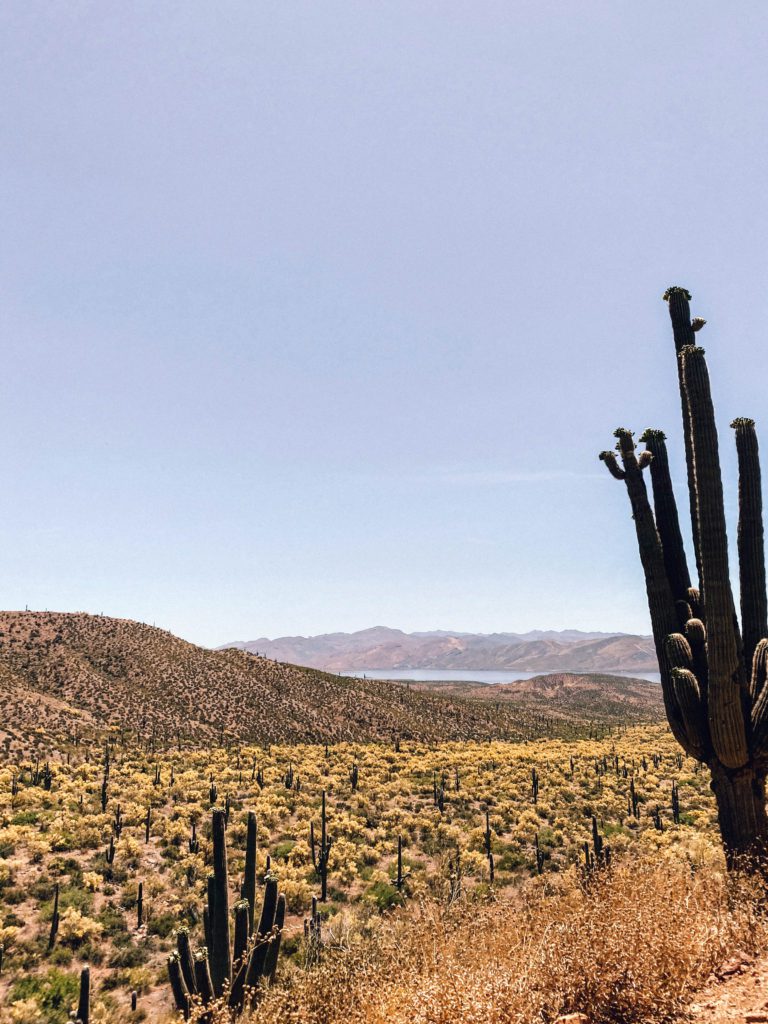
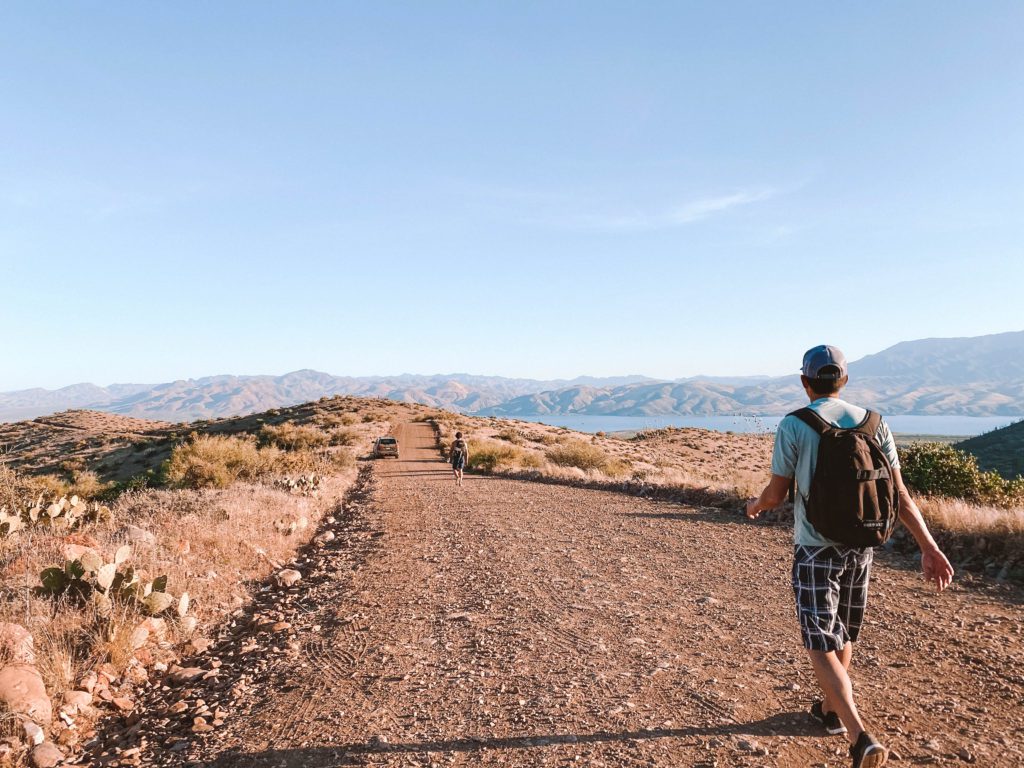
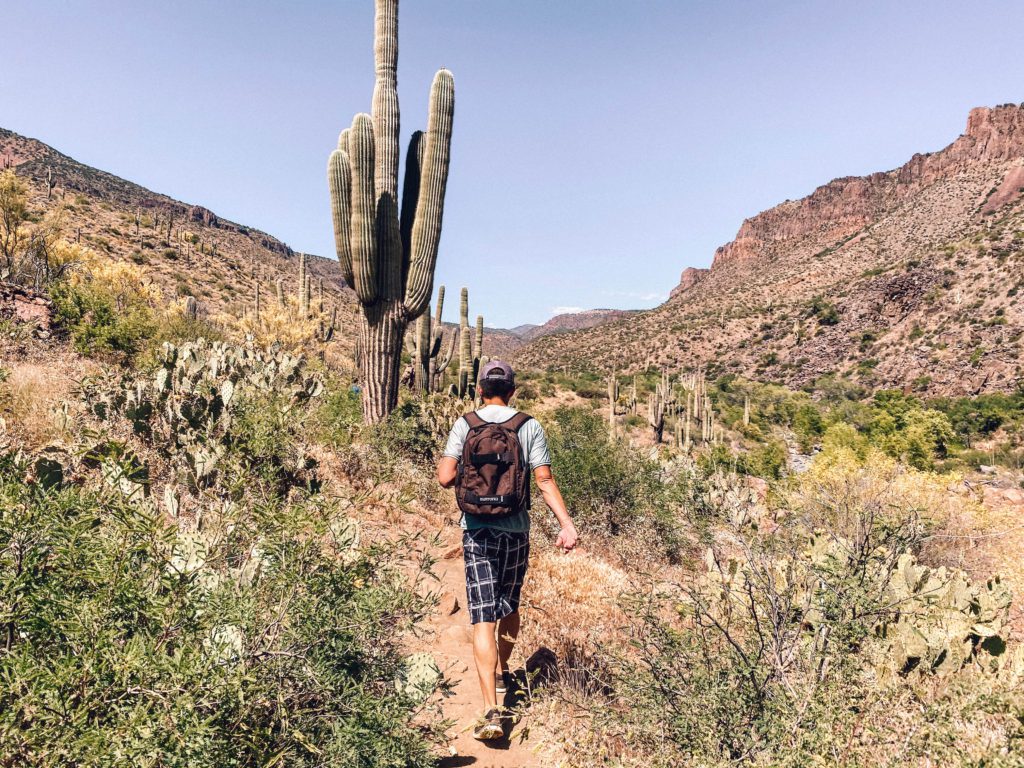

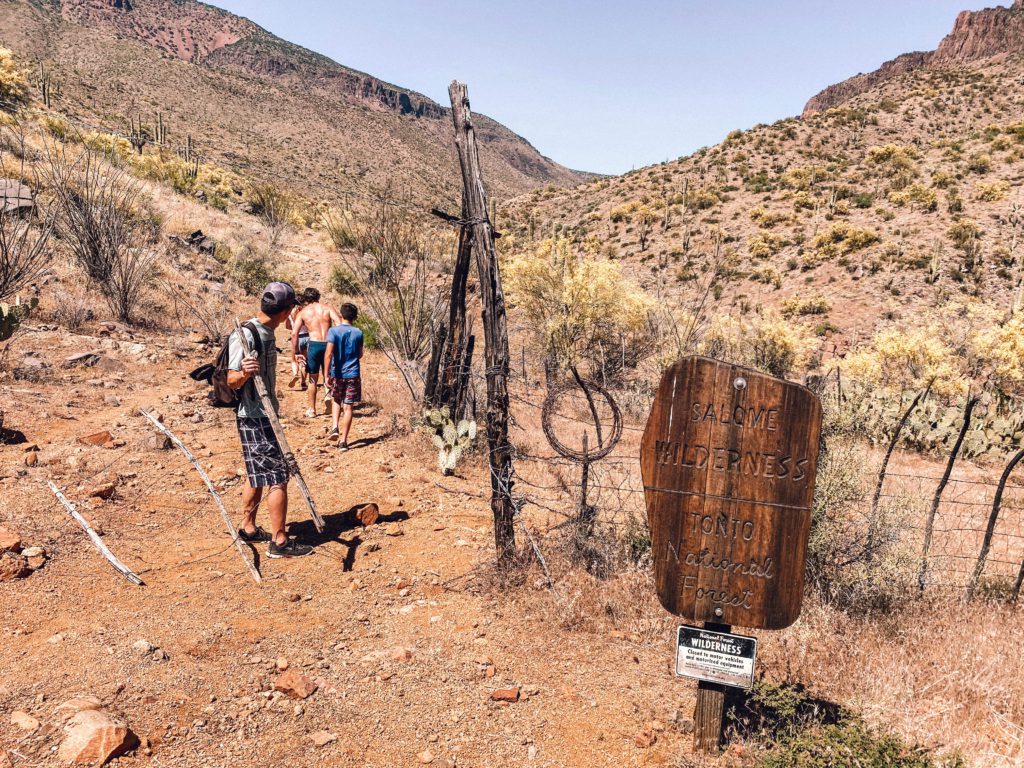
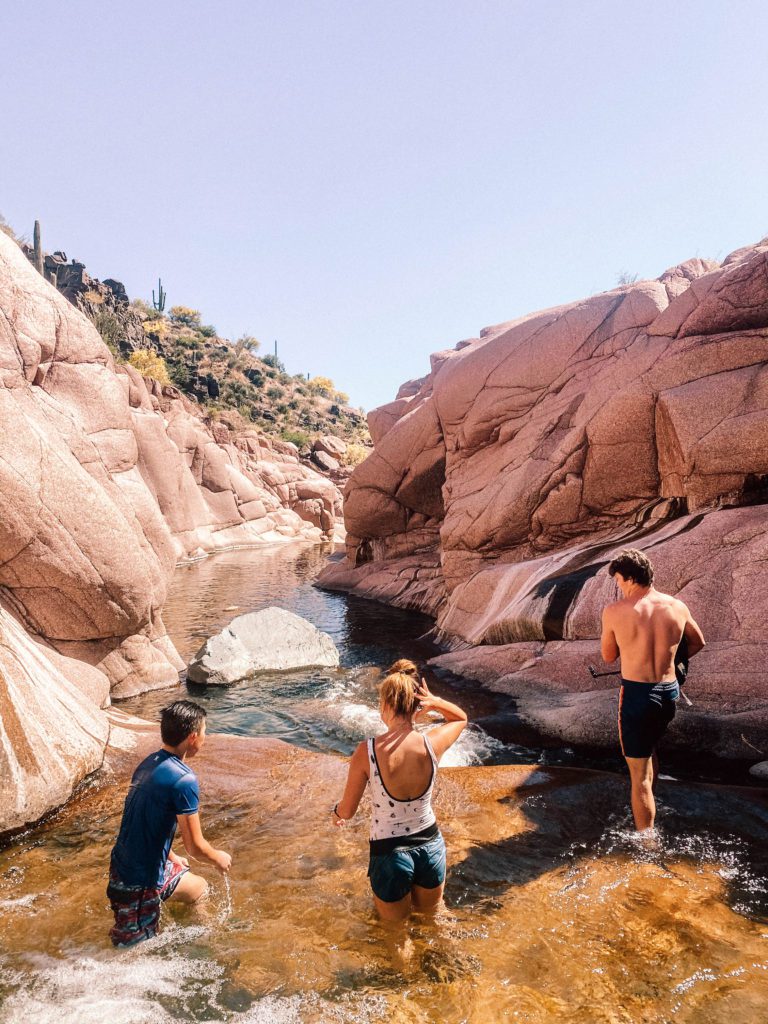
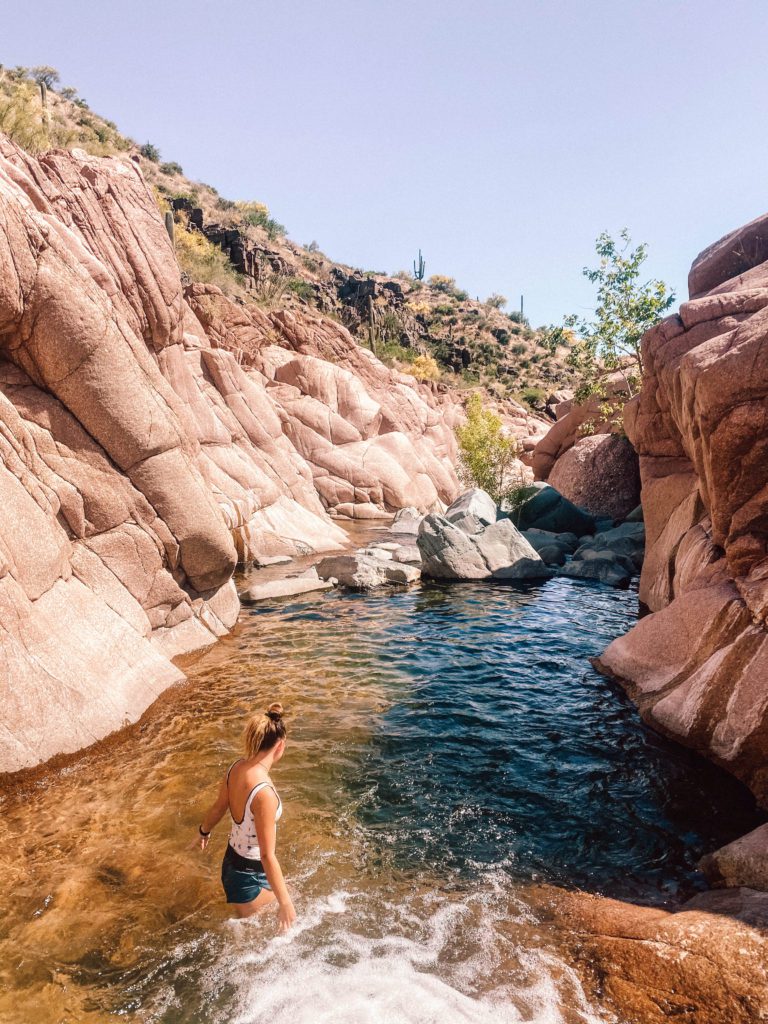
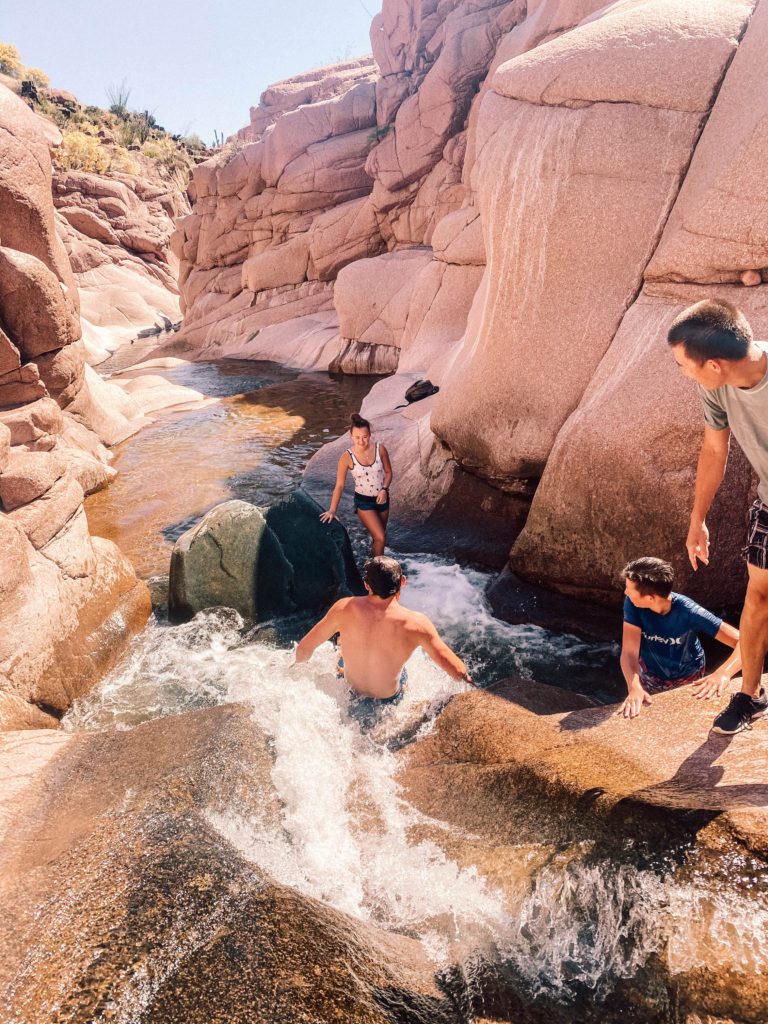
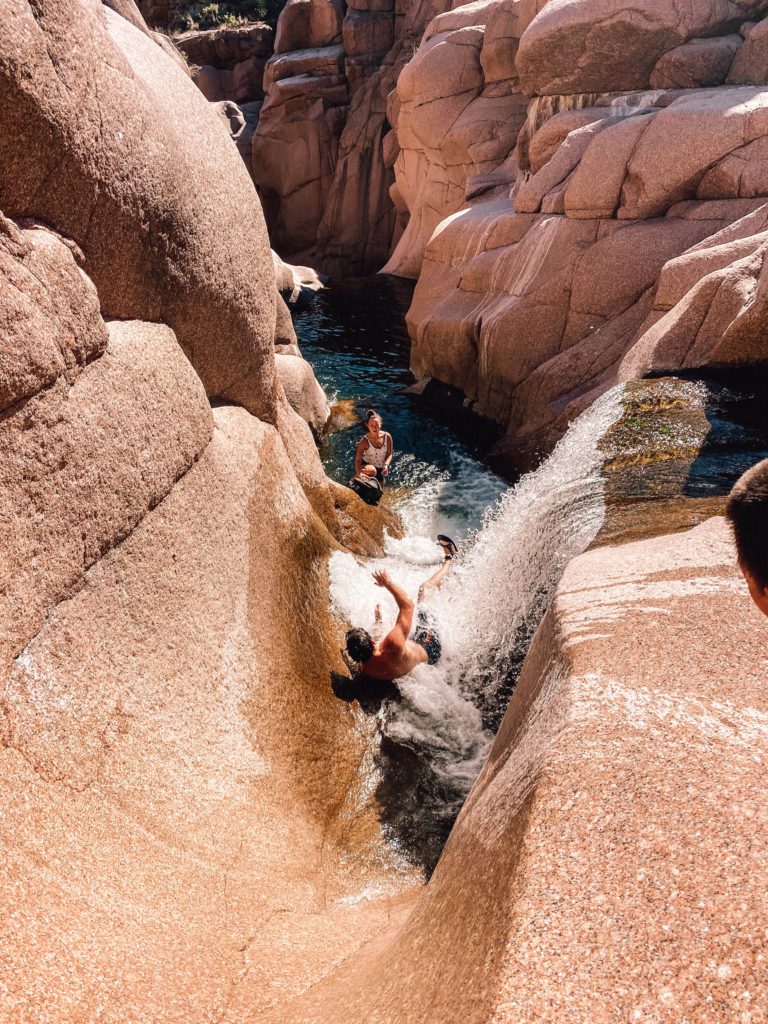
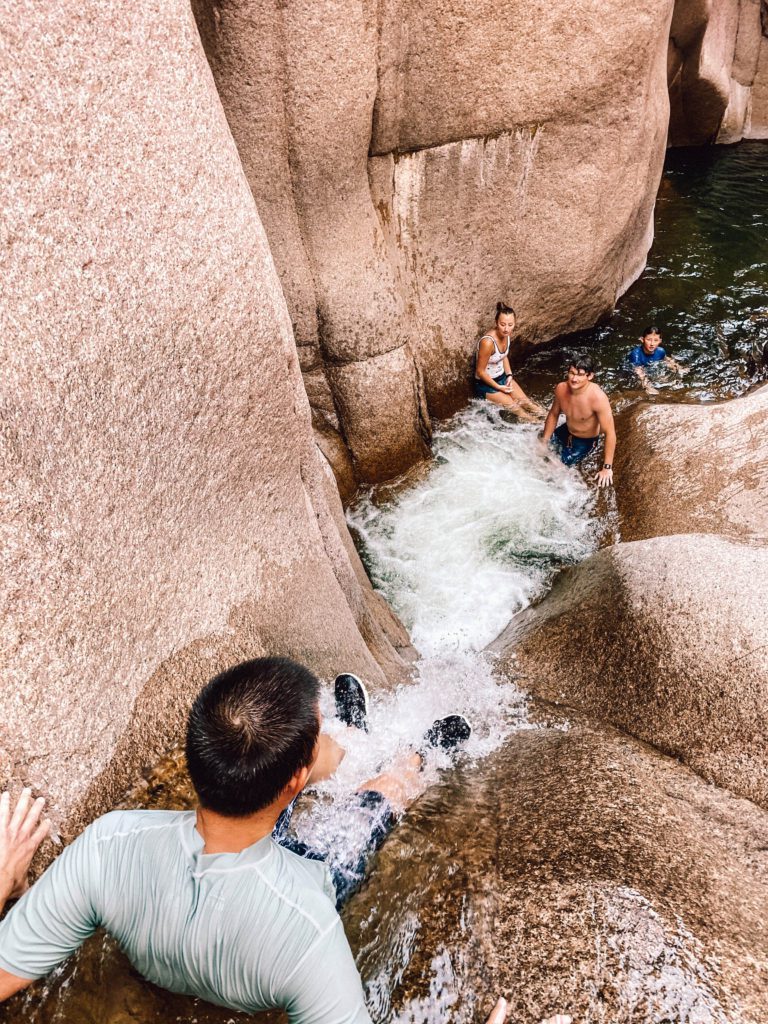
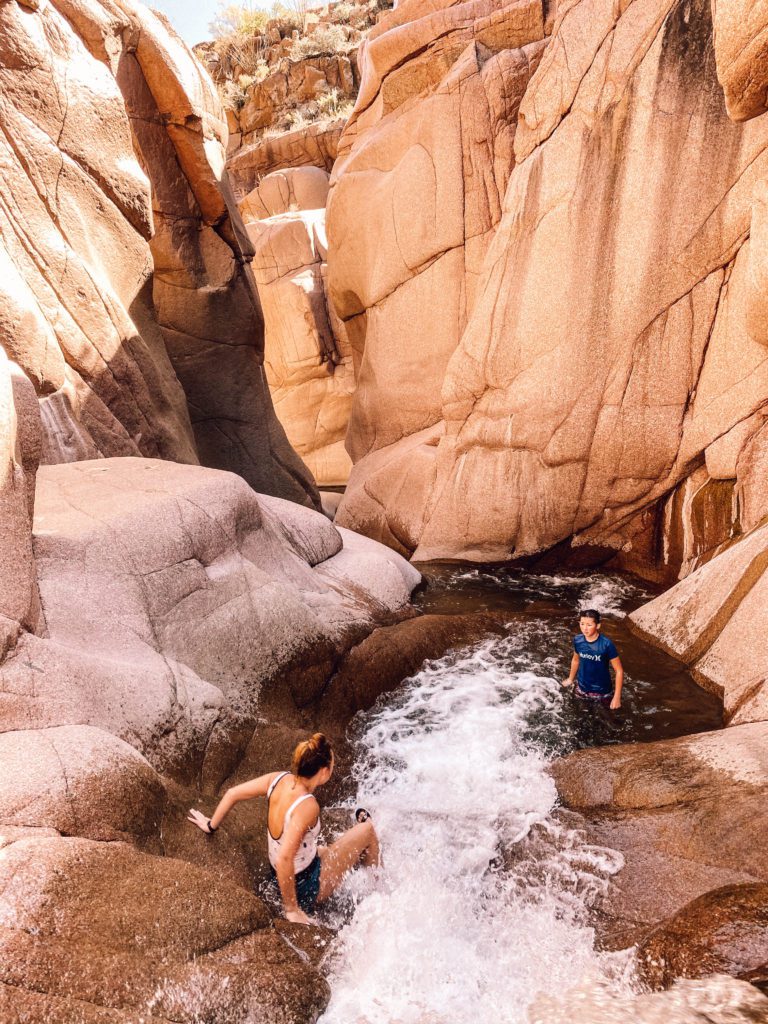

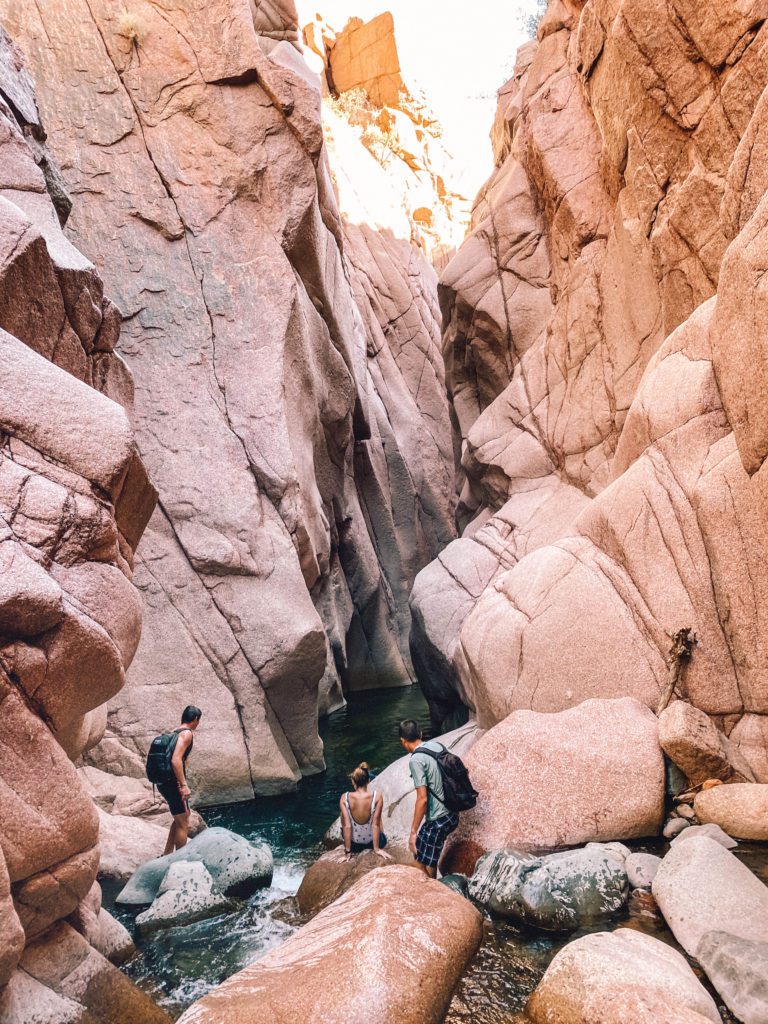
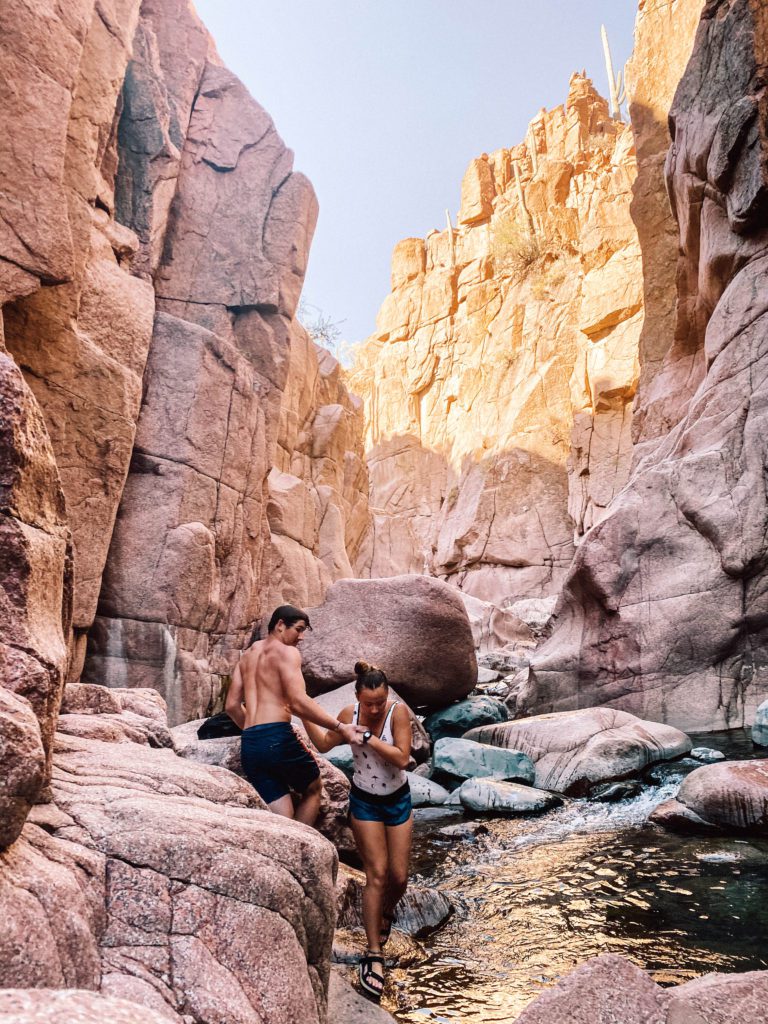
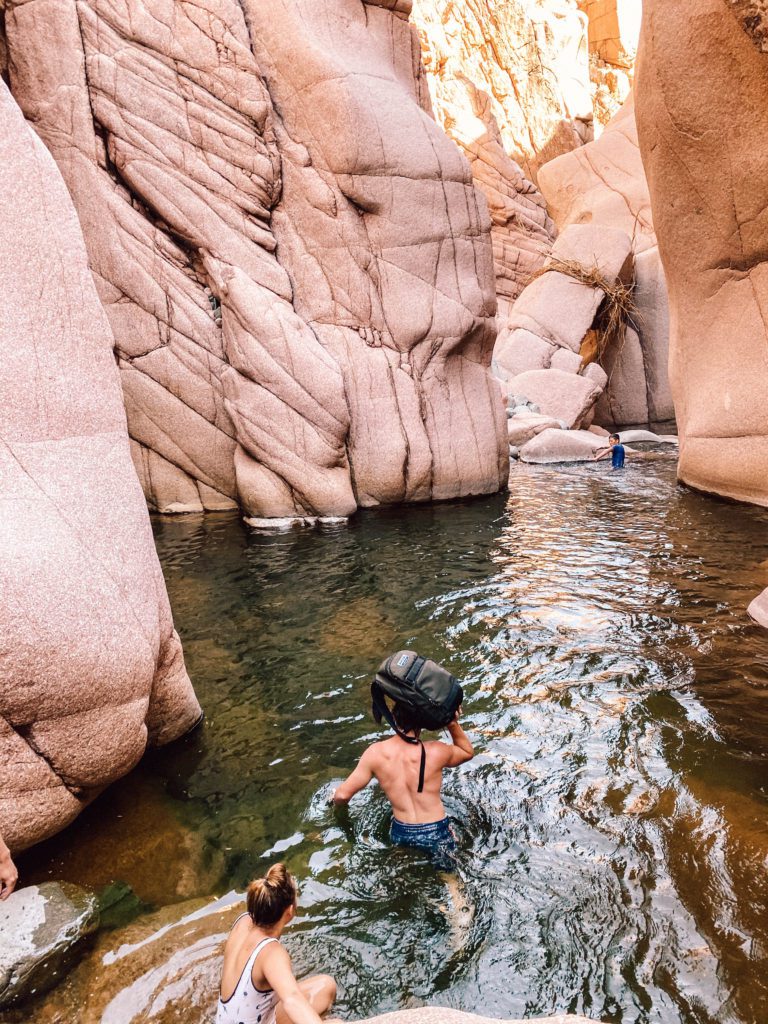
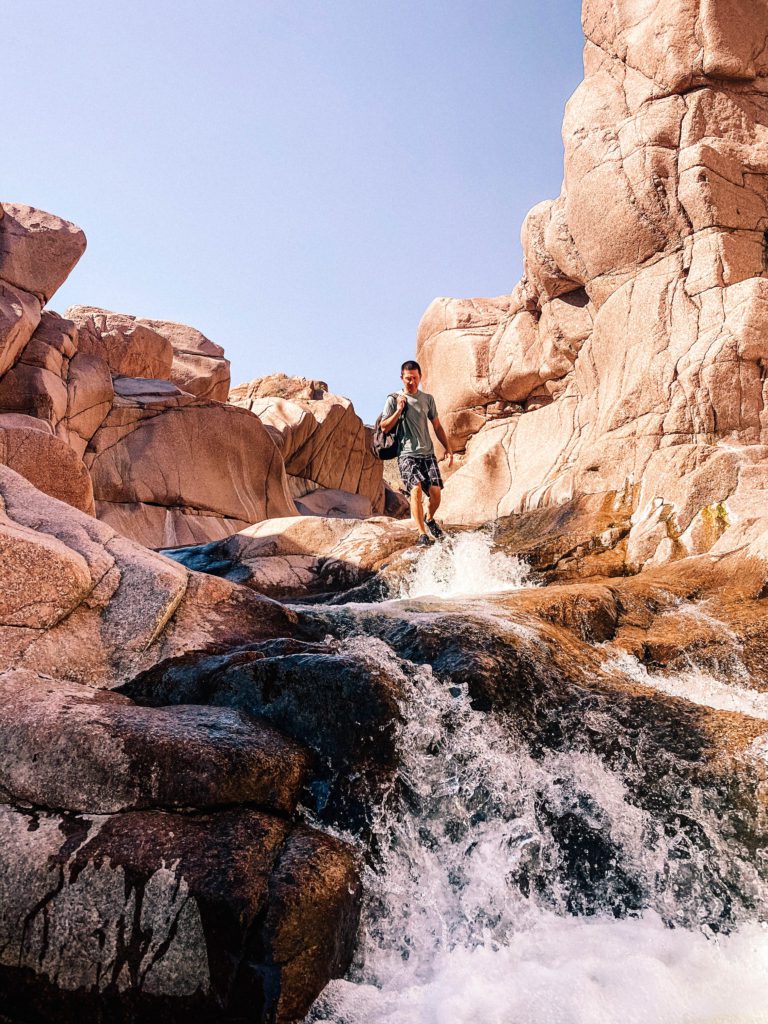
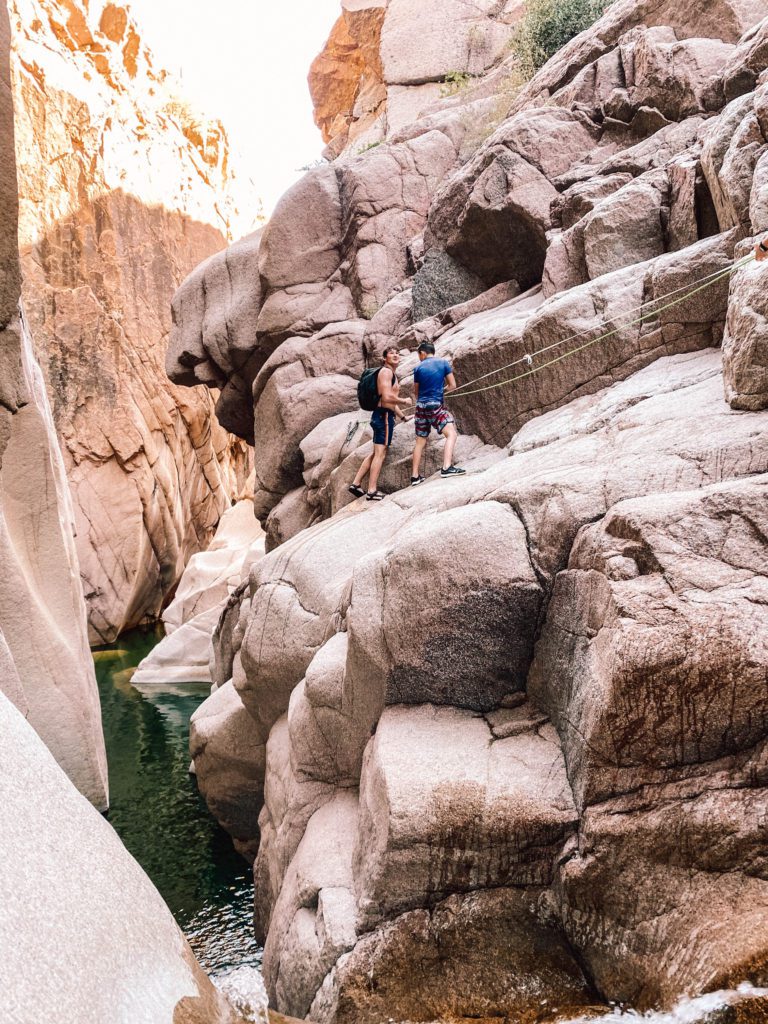
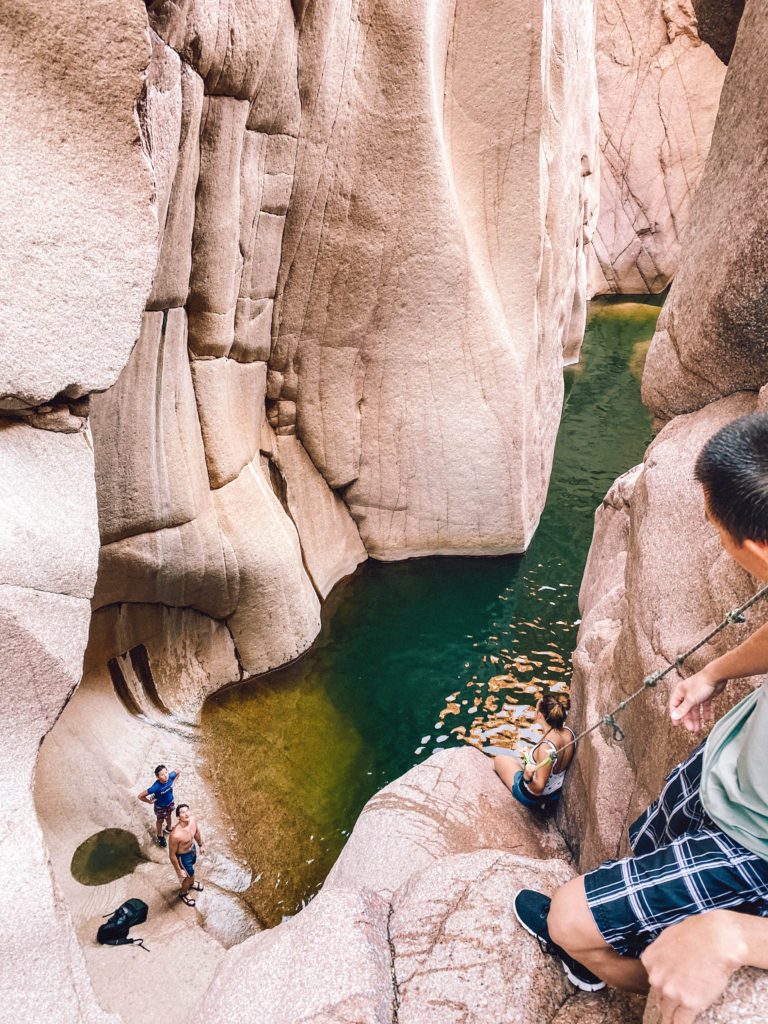
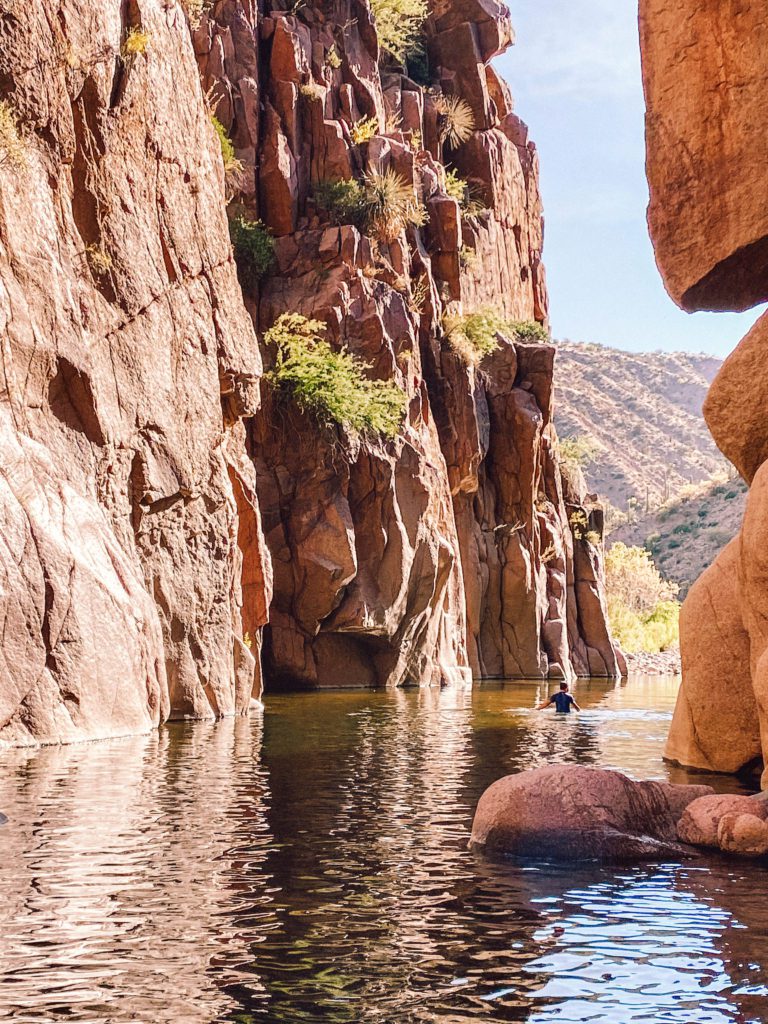

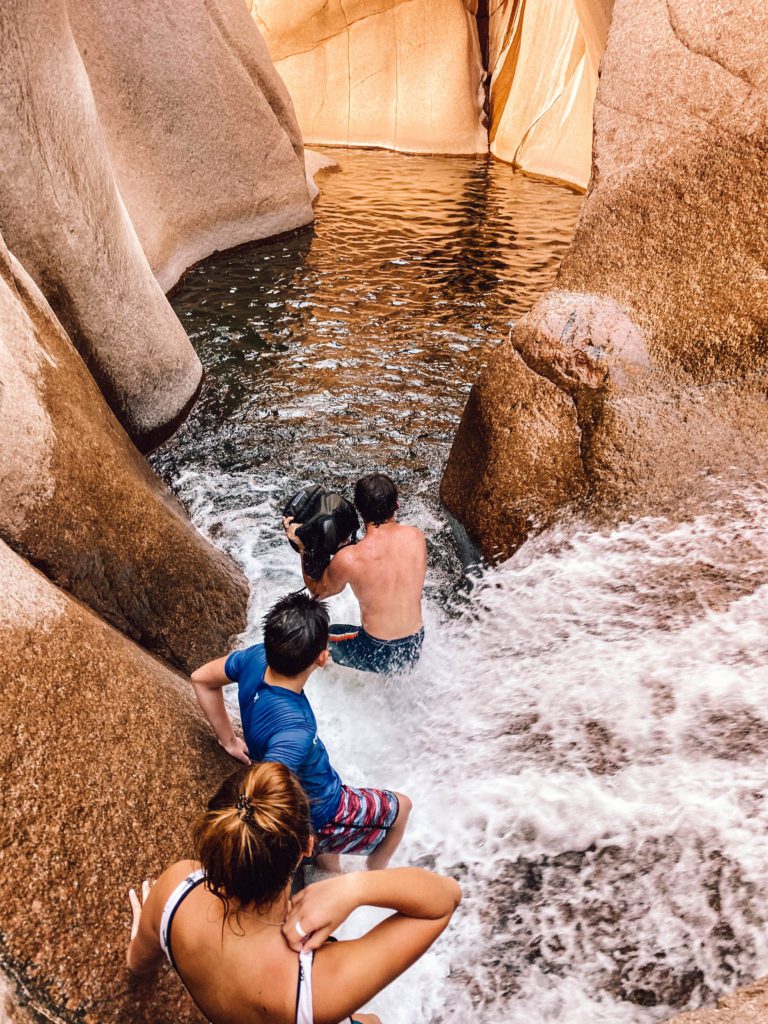
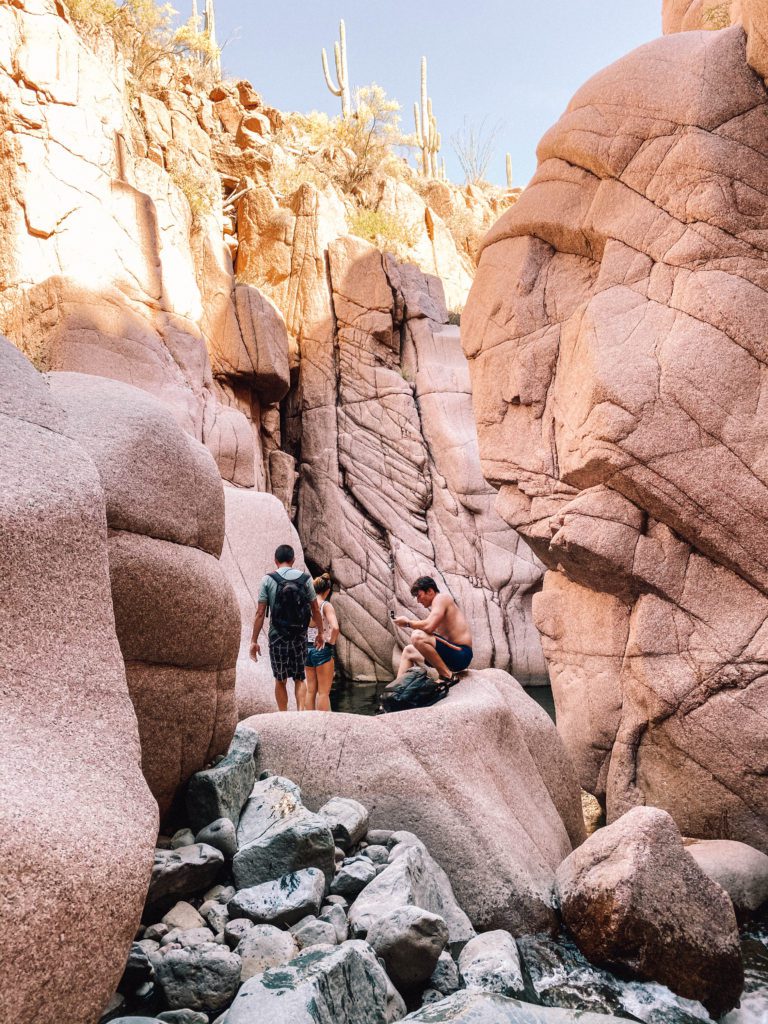
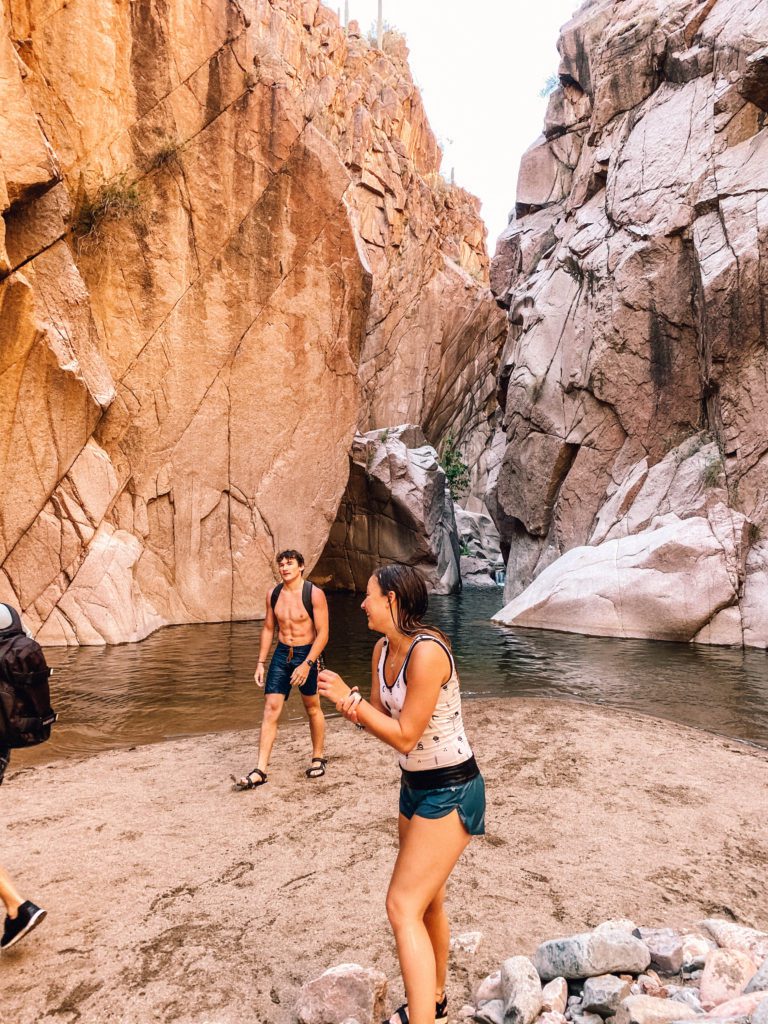




Arizona is likely the most beautiful and challenging state. Can’t swim, afraid of heights but love this; you described it perfectly.
Thanks Patty! Yes, lots of outdoor adventures, that’s for sure, but plenty of beauty on dry low ground too 🙂
Thanks for reminding people to “pack it out”. Over the years Arizona wilderness has been getting trashed.
It is unfortunate that people even need the reminder, it really is sad to see!
A good tip is to put a pool noodle in your pack. They weigh next to nothing and allow you to use your pack as a kickboard or flotation device.
Great tip, thanks for sharing!
Be very aware that the consequences of slipping while traversing to the “platform” on the final jump are VERY high. I’m a climber, caver, and on a mountain rescue team and this is sketch at best…
For those of us that know we don’t want to do the jump is possible to reach the falls doing the hike backwards and just enjoy a small section of the canyon?
The jump is at the very end, so you could hike down to the pool at the bottom. You could also play in the pools at the beginning of the hike. Just use caution because on some of the waterslides you won’t be able to climb back up, so only go as far as you are confident that you will be able to backtrack to the beginning.